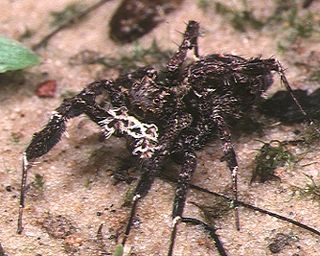
Jumping spiders or the Salticidae are a family of spiders. As of 2019, it contained over 600 described genera and over 6000 described species, making it the largest family of spiders at 13% of all species. Jumping spiders have some of the best vision among arthropods and use it in courtship, hunting, and navigation. Although they normally move unobtrusively and fairly slowly, most species are capable of very agile jumps, notably when hunting, but sometimes in response to sudden threats or crossing long gaps. Both their book lungs and tracheal system are well-developed, and they use both systems. Jumping spiders are generally recognized by their eye pattern. All jumping spiders have four pairs of eyes, with the anterior median pair being particularly large.
Allodecta is a monotypic genus of jumping spiders containing the single species, Allodecta maxillaris. It was first described by E. B. Bryant in 1950, and is only found on the Greater Antilles.

Anasaitis is a genus of jumping spiders that was first described by E. B. Bryant in 1950. The name is derived from the salticid genus Saitis.
Antillattus is a genus of Caribbean jumping spiders that was first described by E. B. Bryant in 1943. The name is a combination of "Antilles" and the common ending for salticid genera -attus.
Ballognatha is a spider genus of the jumping spider family, Salticidae, with the single species B. typica. It occurs in Karakorum.
Compsodecta is a genus of Caribbean jumping spiders that was first described by Eugène Louis Simon in 1903.

Messua is a spider genus of the family Salticidae.
Opisthoncana is a monotypic genus of jumping spiders containing the single species, Opisthoncana formidabilis. It was first described by Embrik Strand in 1913, and is only found on New Ireland. The name is a variation of the salticid genus Opisthoncus.
Paraplexippus is a genus of Caribbean jumping spiders that was first described by P. Franganillo B. in 1930. As of August 2019 it contains only two species, found only on the Greater Antilles: P. quadrisignatus and P. sexsignatus. The name is a combination of the Ancient Greek "para" (παρά), meaning "alongside", and the salticid genus Plexippus.
Parasaitis is a monotypic genus of jumping spiders containing the single species, Parasaitis femoralis. It was first described by E. B. Bryant in 1950, and is only found on the Greater Antilles. The name is a combination of the Ancient Greek "para" (παρά), meaning "alongside", and the salticid genus Saitis.
Parathiodina is a monotypic genus of jumping spiders containing the single species, Parathiodina compta. It was first described by E. B. Bryant in 1943, and is only found on Hispaniola. The name is a combination of the Ancient Greek "para" (παρά), meaning "alongside", and the salticid genus Thiodina.
Pensacolops is a monotypic genus of Brazilian jumping spiders containing the single species, Pensacolops rubrovittata. It was first described by M. J. Bauab V. in 1983, and is only found in Brazil. The name is a combination of the salticid genus Pensacola and the Ancient Greek "-ops" (ὄψ), meaning "to look like". The species name is a combination of the Latin rubrus, meaning "red", and vittatus, which means "striped".

Platycryptus is a genus of jumping spiders that was first described by D. E. Hill in 1979.

Pseudemathis is a monotypic genus of African jumping spiders containing the single species, Pseudemathis trifida. It was first described by Eugène Louis Simon in 1902, and is found only in Africa. The name is a combination of the Ancient Greek "pseudo-" (ψευδής), meaning "false", and the salticid genus name Emathis.
Pseudocorythalia is a monotypic genus of Guatemalan jumping spiders containing the single species, Pseudocorythalia subinermis. It was first described by Lodovico di Caporiacco in 1938, and is found only in Guatemala. The name is a combination of the Ancient Greek "pseudo-" (ψευδής), meaning "false", and the salticid genus name Corythalia.
Thianella is a possible monotypic genus of jumping spiders containing the single species, Thianella disjuncta. It was first described by Embrik Strand in 1907, and is found only on Java. Based on a male specimen, Roewer placed it close to Thiania, but his placements of salticids have often been questionable and no drawings currently exist. The name is an alteration of the salticid genus Thiania, and the species name is from Latin disiunctus "separated". The World Spider Catalog regards the genus and species names as nomina dubia.

George Williams Peckham and Elizabeth Maria Gifford Peckham were a married couple who were early American teachers, taxonomists, ethologists, arachnologists, and entomologists, specializing in animal behavior and in the study of jumping spiders and wasps.

Euophryini is a tribe of jumping spiders. It has also been treated as the subfamily Euophryinae.

Portia fimbriata, sometimes called the fringed jumping spider, is a jumping spider found in Australia and Southeast Asia. Adult females have bodies 6.8 to 10.5 millimetres long, while those of adult males are 5.2 to 6.5 millimetres long. Both sexes have a generally dark brown carapace, reddish brown chelicerae ("fangs"), a brown underside, dark brown palps with white hairs, and dark brown abdomens with white spots on the upper side. Both sexes have fine, faint markings and soft fringes of hair, and the legs are spindly and fringed. However, specimens from New Guinea and Indonesia have orange-brown carapaces and yellowish abdomens. In all species of the genus Portia, the abdomen distends when the spider is well fed or producing eggs.
Elizabeth Bangs Bryant was an American arachnologist. She worked at the Museum of Comparative Zoology in Cambridge, Massachusetts and was a close acquaintance of James Henry Emerton. She is best known for her studies of the spiders of New England and the Caribbean.







